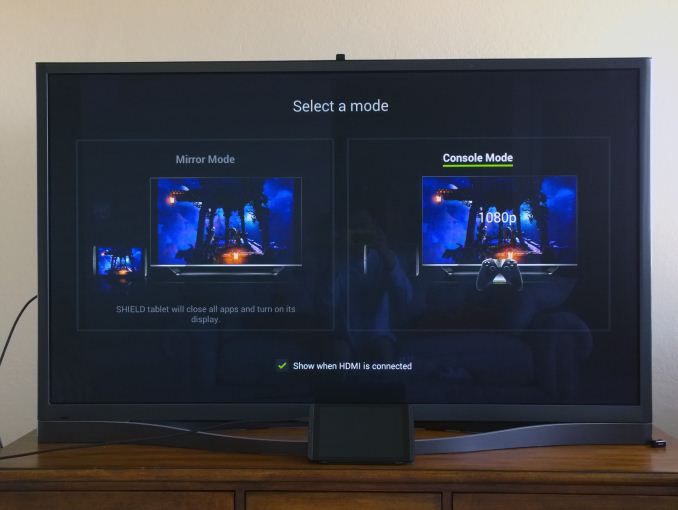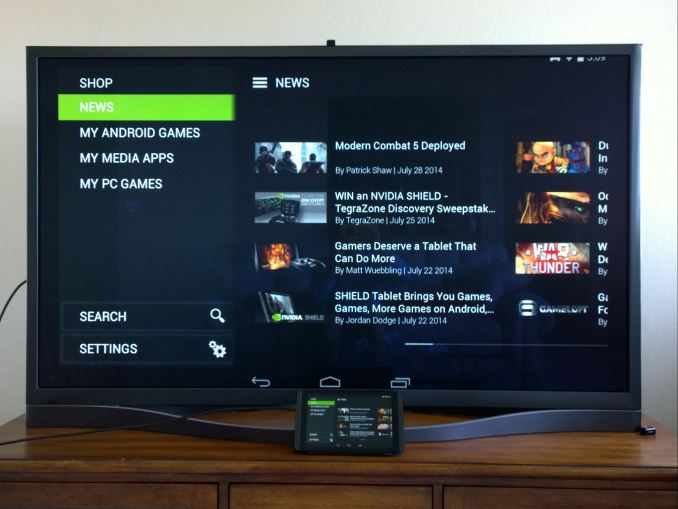The NVIDIA SHIELD Tablet Review
by Joshua Ho on July 29, 2014 9:00 AM ESTSoftware
In the UI department, there’s not too much to talk about. Much like Motorola, NVIDIA has stuck to using the AOSP UI design. Of course, there are plenty of NVIDIA-specific applications, but I didn’t run into any issues using the tablet to do everyday tasks. In this respect, things have improved massively over Shield portable. Because this tablet works in both portrait and landscape, there aren’t any issues with applications that force portrait mode like there were with the Shield portable. In normal tablet usage, it works as one might expect, with no real perceived lag throughout the UI. Of course, this is when compared to other Android devices. There are still frame drops involved in scrolling through lists and similar areas where Android has traditionally struggled to stay smooth, but Android L should fix this issue for the most part.
DirectStylus 2
The real value that the Shield tablet brings as a tablet is the stylus functionality. DirectStylus 2 is definitely much, much better than any other capacitive stylus on the market. The tip allows for precise control and it’s definitely responsive to changes in pressure. For the most part, there are only small issues here. Because the stylus is capacitive, it’s not really possible to have a floating pointer the way Wacom styluses do. In addition, I noticed that I need to lift the stylus a bit more than I might with pencil and paper in order to start a new letter or word or else my words would start to flow together. For the most part though, it works well enough, and the inking latency is low. Unfortunately the issue here is more of ecosystem than hardware, as most stylus-enabled applications aren’t nearly as robust as OneNote on Windows x86.
Console Mode
Of course, the real question here is whether the gaming side is worth the price premium. NVIDIA has gone all out on this area, and their efforts are split up into multiple aspects. The first is the TV interface/console mode, then the gameplay recording feature known as ShadowPlay. Finally, there’s the aspect of GameStream and GRID, which make it possible for games to be played on the tablet that otherwise wouldn’t work due to the compute requirements.
The TV interface effectively boils down to Shield Hub and Google Now, although it’s fully possible to use the full tablet UI as desired in this mode. In the hub, launching games and various applications like YouTube and Netflix is rather simple compared to the more cumbersome full Android UI as they have their own category in Shield Hub. In addition, launching applications through Google Now works as expected. Overall, there aren’t any friction points here. It works as well as one could expect. There is a strong reliance on voice input in general, but it’s much better than trying to type with a controller and better than most smart TV experiences. While the TV interface is mostly targeted towards enabling a console gaming experience, YouTube and Netflix both work great in this mode. NVIDIA has also gone through the necessary DRM certification process to allow for 1080p Netflix streaming. In essence, this device is already ready to serve as an Android TV device.
ShadowPlay
ShadowPlay, which we first saw in GeForce GTX GPUs, is also another major advantage that NVIDIA brings to the table for software experience. In short, this leverages the hardware H.264 video encoder that is on the Tegra K1’s Kepler GPU to provide video capture of gameplay or anything else displayed by the tablet. There are three possible options for video capture. The first is Twitch broadcasting, something that NVIDIA is quite proud of as they are the first to implement such a feature in an Android tablet. While I personally don’t stream on Twitch, a demo of Twitch broadcasting in the initial launch briefing worked without any visible quality issues in either audio or video.
There are two other recording modes. One is a standard start/stop recording feature, but the other is ShadowPlay/Auto Recording. In short, this keeps anywhere from the past minute to 20 minutes in video. This makes it possible to set and forget about the recording feature rather than constantly managing recordings in manual mode. All of these modes can use the tablet’s microphone and front facing camera for commentary purposes as needed. Local recordings seem to have a maximum of 1080p30, and Twitch broadcasts are limited to 720p30.
While those are the technical details, it’s a painless process. All the user has to do is long press the back button on the controller and select what kind of a recording they’d like to do (Twitch, Auto, Manual, Screenshot) and that’s it. I can see significant potential in this area especially if this device takes off as a gaming platform.
















174 Comments
View All Comments
fivefeet8 - Tuesday, July 29, 2014 - link
Those arguments are the same ones made with the advent of gaming laptops and desktops. I can agree that the market for both is in the minority, but something needs to push the technology forward. At this point, the mobile space is ruled mostly by companies with technologies both hardware and software that have stagnated. Mostly because of the market conditions leaving pretty much only Qualcomm technology, but that has also caused them to become complacent to a large degree when it comes to software.schizoide - Tuesday, July 29, 2014 - link
Not really. Back in the day, games drove PC gaming hardware. You would go out and buy that new 3dfx card to play Quake 2. These days most PC games are console ports and low to mid-end hardware can play them just fine.Difference is that today there's an incredibly huge market full of mobile games with very modest hardware requirements, and very few are willing to release titles requiring top line hardware because the perception is those "core" gamers have consoles or gaming PCs.
You're right that if nobody builds mobile devices with higher-end capabilities those games will _certainly_ never come. That's dead on. But at the same time, I'm not going to buy a gaming device without an exclusive game that I really want. And 10 year old PC ports like portal don't cut it.
fivefeet8 - Tuesday, July 29, 2014 - link
That's the same argument you are making against the Shield Tablet. That it's hardware is not needed because most games run fine on lesser powered machines. Software has been playing catchup to PC hardware for years now, but we still have high end hardware to push the envelope.In any case, with the new Shield is a tablet that can do more than most on the market right now while still being able to push the technology forward. And you are correct, I wouldn't buy a gaming device either without a few games I really want, but then I'm not buying it simply for a gaming device only.
savagemike - Tuesday, July 29, 2014 - link
You might not buy a gaming device in that scenario. But this isn't just a gaming device it's also a tablet and as such can fill multiple uses.I'm not positive I'm going to buy one but I might. It's definitely on the list for consideration because it is so flexible. I wanted an 8"+ tablet and would very much like a stylus. Wasn't digging the extra price of the Samsung stylus models though.
For $300 this thing seems like it does lots of stuff pretty well. I would be surprised if there are not bundles for $325 or so that include the tablet and controller come the holidays.
We'll see. Want to see what the 64x version looks like too and also how pricing and quality play out for Android TV.
ArthurG - Tuesday, July 29, 2014 - link
comparing refurb price of a 6 months old item to a brand new model coming out today, very very fair...schizoide - Tuesday, July 29, 2014 - link
Sure. Why not? Money is money. You want to buy a small android tablet, Nexus 7 is at the top of your list, right?Friendly0Fire - Tuesday, July 29, 2014 - link
A lot of people don't consider refurbs. I know I don't.schizoide - Tuesday, July 29, 2014 - link
Fair enough, then it's only a 25% price premium. Certainly much more attractive, then.abrowne1993 - Tuesday, July 29, 2014 - link
The biggest problems I have with my 2013 Nexus 7 are CPU and GPU performance. If I didn't already have that tablet, I'd buy this one in a heartbeat.TheJian - Wednesday, July 30, 2014 - link
You must be kidding, comparing a refurb of an AGING product to a new product? $230 is the comparison, and for $70 extra you kick the crap out of nexus 7 2013. I didn't realize $300 was 2x $230. I guess I failed math.All the new games that come along with 20nm will likely have problems on that old thing, where K1 will keep on chugging (K1 will be the lowest common denominator next year at 20nm everywhere, and M1 or whatever they call maxwell version will be the new king). Not really interested in running all the games that are built for the lowest common denominator that will run on your aunt's galaxy s2. I'm interested in modern combat 5, asphalt 8, Ravensword, Dungeon Hunter 4 etc. All the stuff coming out this year and forward will get more potent. Though the old stuff is pretty nice too. The library keeps getting larger on android monthly.
Will they sell a lot of them? Tell that to google, they'll be using K1 in HTC Nexus 9. I'm guessing 10mil+ sell in that unit alone and it will probably be $400-500 ;) $300 for a tablet that blows everything else in it's class away is cheap. Get off welfare, get a better job etc and $300 won't sound like much more than $230...ROFL.
One of the other reviews did fine from North Dakota 1600 miles from California ;) Troll somewhere else please. Most of the ports have never sold more than 11mil (halflife2, Portal, Trine2 etc) so most people have never played the ports you're hating on. There are 1.2B android devices sold yearly now and growing. Next year with 20nm chips being at K1 level there will be 1.2B+ units top to bottom that can handle what K1 is doing and that will be what will create major game improvements. Everyone will be holding an Xbox360/ps3 in their hands that can act as a console output to tv. We're not talking angry birds any more even today. BTW, Trine2 came out 2011, Serious Sam3 BFE 2011, Portal 2008. We will start to see even more now especially after HTC Nexus9 hits. Not to mention companies like Gameloft, WB etc creating some top level stuff.